Egyptian Vulture, Aasgier, Schmutzgeier, Abutre do Egipto, Alimoche Comúm
Spotted in the Alentejo region of Portugal. Egyptian Vulture sound
The Egyptian Vulture (Neophron percnopterus), also called the White Scavenger Vulture or Pharaoh’s Chicken, is a small Old World vulture and the only member of the genus Neophron. It is widely distributed; the Egyptian Vulture is found from southwestern Europe and northern Africa to India.
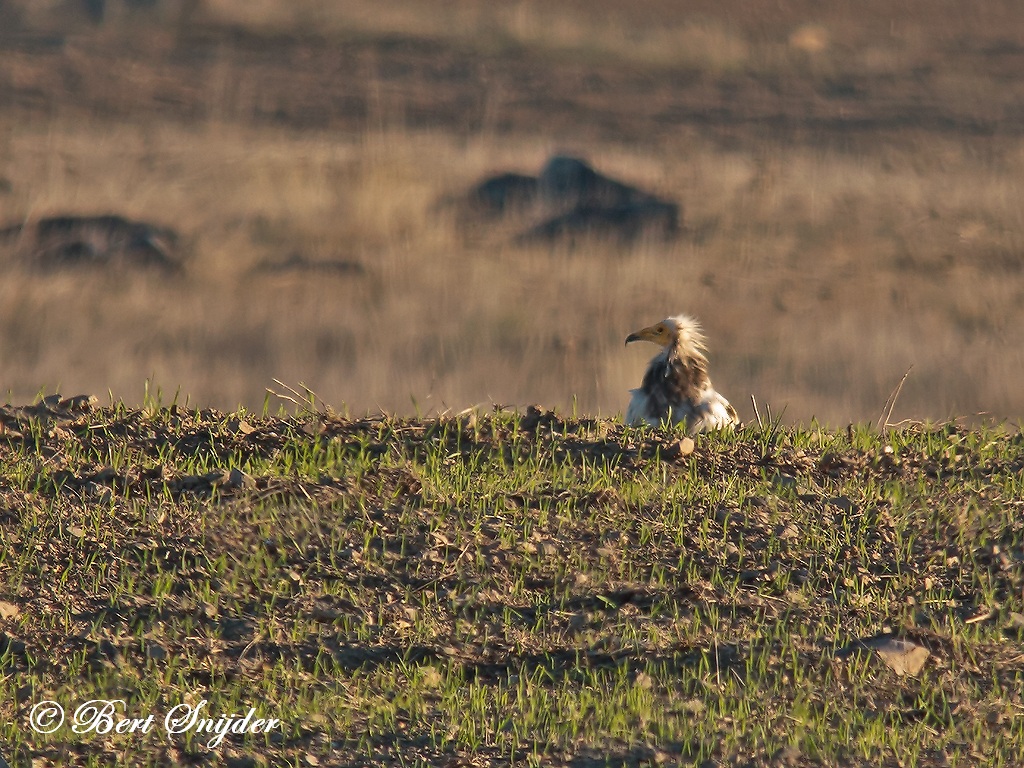
More photos at the bottom of this page:
The contrasting underwing pattern and wedge-shaped tail make it distinctive in flight as it soars in thermals during the warmer parts of the day. Egyptian Vultures feed mainly on carrion but are opportunistic and will prey on small mammals, birds, and reptiles. They also feed on the eggs of other birds, breaking larger ones by tossing a large pebble onto them. The use of tools is rare in birds and apart from the use of a pebble as a hammer, Egyptian Vultures also use twigs to roll up wool for use in their nest. Egyptian Vultures that breed in the temperate regions migrate south in winter while tropical populations are relatively sedentary. Populations of this species have declined in the 20th century and some island populations are endangered by hunting, accidental poisoning, and collision with power lines.
The adult’s plumage is white, with black flight feathers in the wings. Wild birds usually appear soiled with a rusty or brown shade to the white plumage, derived from mud or iron-rich soil. Captive specimens without access to soil have clean white plumage. The bill is slender and long, and the tip of the upper mandible is hooked. The nostril is an elongated horizontal slit. The neck feathers are long and form a hackle. The wings are pointed, with the third primary being the longest; the tail is wedge shaped. The legs are pink in adults and grey in juveniles. The claws are long and straight, and the third and fourth toes are slightly webbed at the base. The bill is black in the nominate subspecies but pale or yellowish in adults of the smaller Indian ginginianus. Rasmussen and Anderton (2005) suggest that this variation may need further study, particularly due to the intermediate black-tipped bill described in rubripersonatus. The facial skin is yellow and unfeathered down to the throat.
The sexes are indistinguishable in plumage but breeding males have a deeper orange facial skin colour than females.Females average slightly larger and are about 10-15% heavier than males. Young birds are blackish or chocolate brown with black and white patches. The adult plumage is attained only after about five years. The adult Egyptian Vulture measures 47–65 centimetres (19–26 in) from the point of the beak to the extremity of the tail feathers. In the smaller N. p. ginginianus males are about 47–52 centimetres (19–20 in) long while females are 52–55.5 centimetres (20–21.9 in) long. The wingspan is about 2.7 times the body length. Birds from Spain weigh about 1.9 kilograms (4.2 lb) while birds of the Canary Island subspecies majorensis, representing a case of island gigantism, are heavier with an average weight of 2.4 kilograms (5.3 lb).
Egyptian Vultures are widely distributed across the Old World with their breeding range from southern Europe to northern Africa east to western and southern Asia. They are rare vagrants in Sri Lanka. They occur mainly on the dry plains and lower hills. In the Himalayas, they go up to about 2,000 metres (6,600 ft) in summer. European populations migrate south to Africa in winter. Vagrants may occur as far south as in South Africa although they bred in the Transkei region prior to 1923. They nest mainly on rocky cliffs, sometimes adopting ledges on tall buildings in cities and on large trees. Most Egyptian Vultures in the temperate zone migrate south to Africa in winter. Like many other large soaring migrants, they avoid making long crossings over water. Italian birds cross over through Sicily and into Tunisia making short sea crossings by passing through the islands of Marettimo and Pantelleria. Those that migrate through the Iberian Peninsula cross into Africa over the Strait of Gibraltar while others cross further east through the Levant. Migrating birds can sometimes cover 500 kilometres (310 mi) in a single day until they reach the southern edge of the Sahara, 3,500 to 5,500 kilometres (2,200 to 3,400 mi) from their summer home. Young birds that have not reached breeding age may overwinter in the grassland and semi-desert regions of the Sahel.
The Egyptian Vulture is usually seen singly or in pairs, soaring in thermals along with other scavengers and birds of prey, or perched on the ground or atop a building. On the ground, they walk with a waddling gait. They feed on a range of food, including mammal faeces (including those of humans, insects in dung, carrion, vegetable matter, and sometimes small animals. When it joins other vulture species at a dead animal, it tends to stay on the periphery and waits until the larger species leave. Wild rabbits (Oryctolagus cuniculus) form a significant part of the diet of Spanish vultures. Studies suggest that they feed on ungulate faeces to obtain carotenoid pigments responsible for their bright yellow and orange facial skin. The ability to assimilate carotenoid pigments may serve as a reliable signal of fitness.
Egyptian Vultures are mostly silent but make high-pitched mewing or hissing notes at the nest and screeching noises when squabbling at a carcass. Young birds have been heard making a hissing croak in flight. They also hiss or growl when threatened or angry. Egyptian Vultures roost communally on large trees, buildings or on cliffs. Roost sites are usually chosen close to a dump site or other suitable foraging area.
In Spain, summer roosts are formed mainly by immature birds. The favourite roost trees tended to be large dead pines. The number of adults at the roost increases towards June. It is thought that breeding adults may be able to forage more efficiently by joining the roost and following others to the best feeding areas. Breeding birds that failed to raise young may also join the non-breeding birds at the roost during June. The breeding season is in spring. During the beginning of the breeding season, courting pairs soar high together and one or both may make steep spiralling or swooping dives.
The birds are monogamous and pair bonds may be maintained for more than one breeding season and the same nest sites may be reused each year. The nest is an untidy platform of twigs lined with rags and placed on a cliff ledge, building, or the fork of a large tree. Old nest platforms of eagles may also be taken over. Nests placed on the ground are rare but have been recorded in subspecies N. p. ginginianus and N. p. majorensis.
Extra-pair copulation with neighbouring birds has been recorded and may be a reason for adult males to stay close to the female before and during the egg laying period. Females may sometimes associate with two males and all three help in raising the brood. The typical clutch consists of two eggs which are incubated in turns by both parents. The eggs are brick red with the broad end covered more densely with blotches of red, brown, and black. The parents begin incubating soon after the first egg is laid leading to asynchronous hatching. The first egg hatches after about 42 days. The second chick may hatch three to five days later and a longer delay increases the likelihood that it will die of starvation. In cliffs where the nests are located close to each other, young birds have been known to clamber over to neighbouring nests to obtain food. In the Spanish population, young fledge and leave the nest after 90 to 110 days. Fledged birds continue to remain dependent on their parents for at least a month. Once the birds begin to forage on their own, they move away from their parents’ territory; young birds have been found nearly 500 km away from their nest site.
One year old European birds migrate to Africa and stay there for at least one year. A vulture that fledged in France stayed in Africa for three years before migrating north in spring. After migrating back to their breeding areas, young birds move widely in search of good feeding territories and mates. The full adult plumage is attained in the fourth or fifth year. Egyptian Vultures have been known to live for up to 37 years in captivity and at least 21 years in the wild. The probability of survival in the wild varies with age, increasing till the age of 2 and then falling at the age of 5. Older birds have an annual survival probability varying from 0.75 for non-breeders to 0.83 for breeding birds.
Healthy adults do not have many predators, but human activities pose many threats. Collisions with power lines, hunting, intentional poisoning, lead accumulation from ingesting gunshot in carcasses, and pesticide accumulation take a toll on populations. Young birds at the nest are sometimes taken by Golden Eagles, eagle owls, and red foxes. Only rarely do adult birds attempt to drive away predators. Young birds that fall off of cliff ledges may be preyed on by mammalian predators such as jackals, foxes and wolves.
The nominate population, especially in Africa, is known for its use of stones as tools. When a large egg, such as that of an ostrich or bustard, is located, the bird walks up to it with a large pebble held in its bill and tosses the pebble by swinging the neck down over the egg. The operation is repeated until the egg cracks from the blows. They prefer using rounded pebbles to jagged rocks. This behaviour, first reported by Jane Goodall in 1966, has however not been recorded in N. p. ginginianus. Tests with both hand-reared and wild birds suggests that the behaviour is innate, not learnt by observing other birds, and displayed once they associate eggs with food and have access to pebbles. Another case of tool-use described from Bulgaria involves the use of a twig as a tool to roll up and gather strands of wool to use for lining the nest.
Egyptian Vulture populations have declined in most parts of its range. In Europe and most of the Middle East, populations in 2001 were half of those from 1980. In India, the decline has been rapid with a 35% decrease each year since 1999. In 1967–70, the area around Delhi was estimated to have 12,000-15,000 of these vultures, with an average density of about 5 pairs per 10 km2. The exact cause of the decline is not known, but has been linked with the use of the NSAID Diclofenac, which has been known to cause death in Gyps vultures. In Italy, the number of breeding pairs declined from 30 in 1970 to 9 in the 1990s. Nearly all breeding failures were due to human activities.
In Spain, which holds about 50% of the European population suggested causes of decline include poisoning by accumulation of lead, pesticides (especially due to large-scale use in the control of Schistocerca gregaria locust swarms), and electrocution. Windfarms may also pose a threat. Poorly designed power transmission lines in east Africa electrocute many wintering vultures. Furthermore, studies in Spain suggest that the absorption of veterinary antibiotics suppresses the vultures’ innate immunity, making them more prone to infection. A shortage of carrion resulting from new rules for disposal of dead animals following the outbreak of Bovine Spongiform Encephalitis in parts of Europe during 2000 may have also had an effect on some populations.
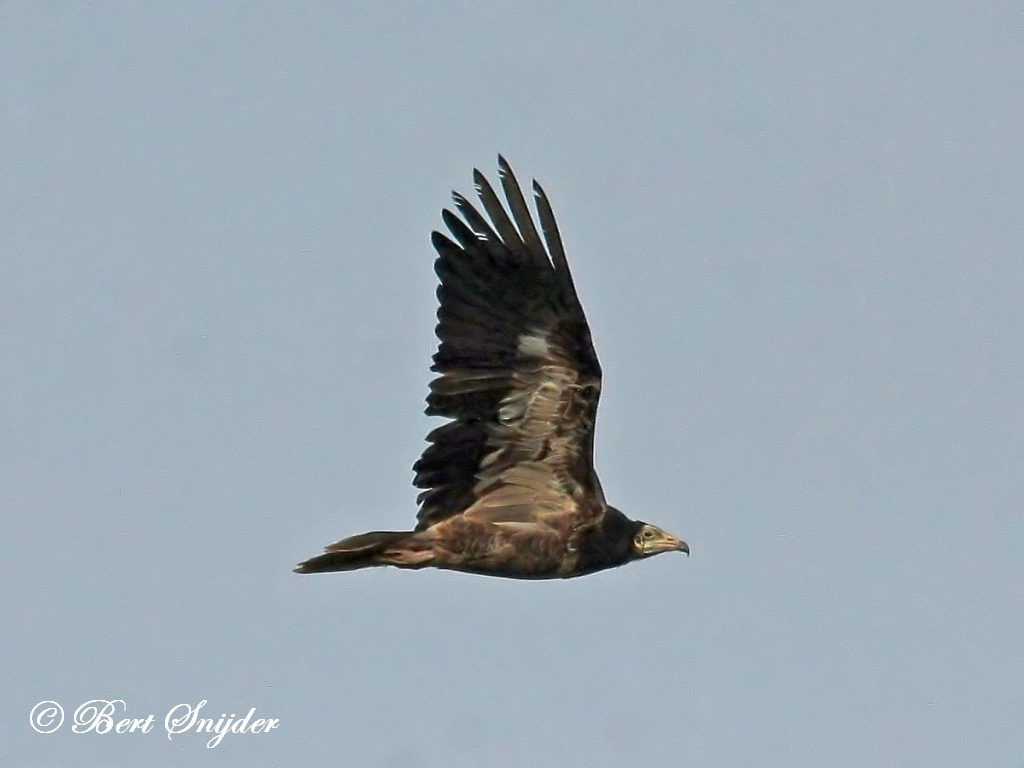
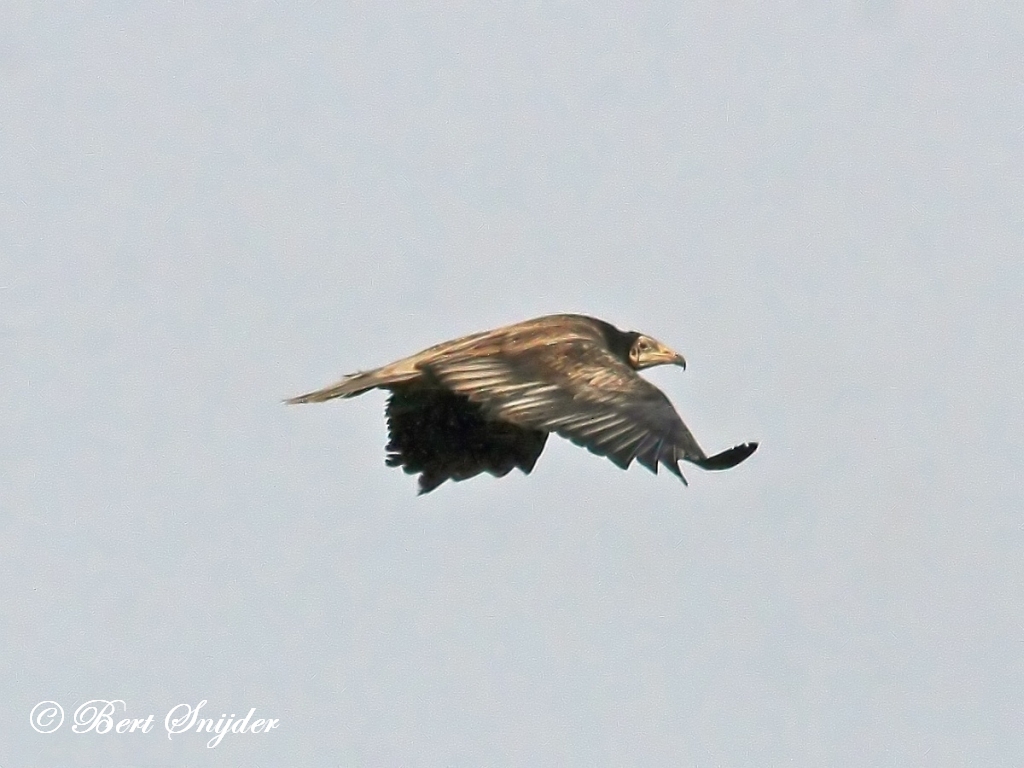
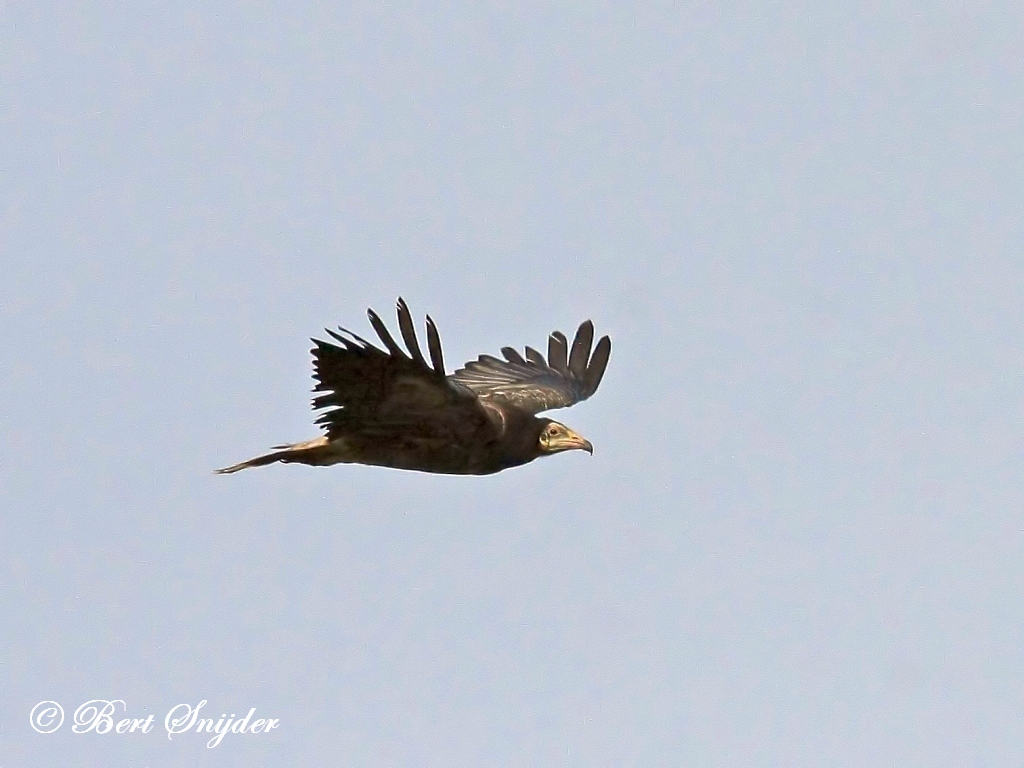
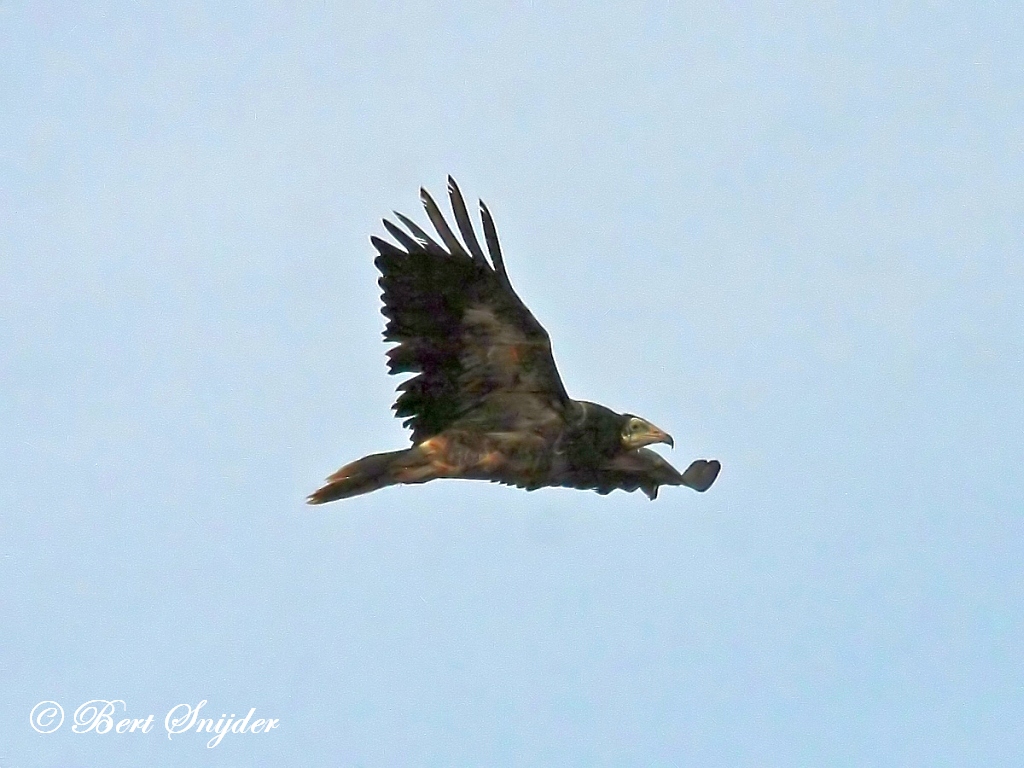
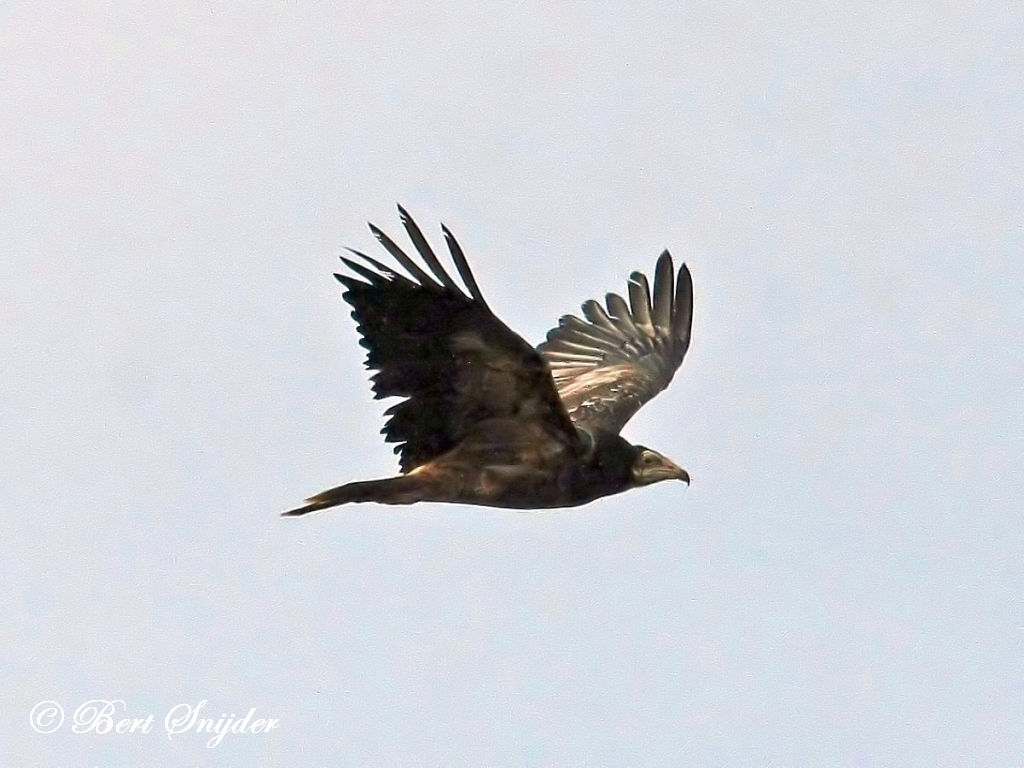
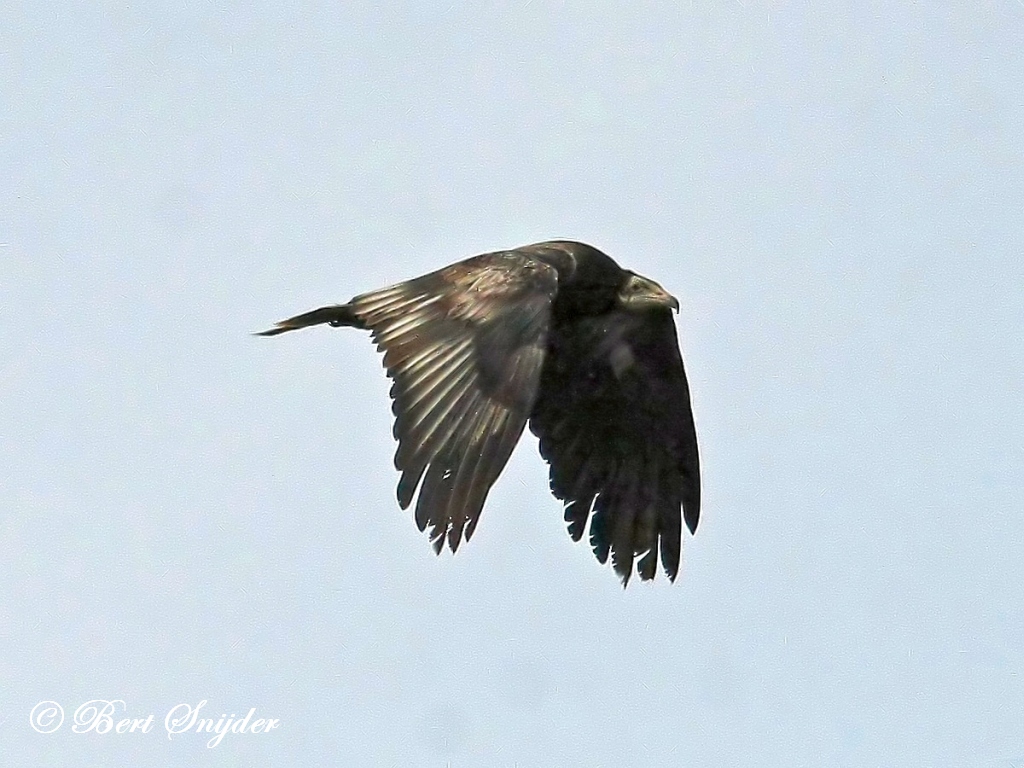
Other synonyms:
Afrikaans: Egiptiese Aasvoël
Asturian: Zapiquera
Catalan: Aufrany, Miloca
Catalan (Balears): Miloca
Czech: Sup mrchožravý
Welsh: Fwltur yr Aifft
Danish: Ådselgrib
German: Schmutzgeier
English: Common Egyptian Vulture, Egyptian Vulture, Scavenger Eagle, Scavenger Vulture, White Scavenger Eagle, White Scavenger Vulture
Esperanto: Kadavrogrifo
Spanish: Alimoche, Alimoche Común
Estonian: raipekotkas
Basque: Aufrany, Sai zuria
Finnish: Pikkukorppikotka
French: Néophron percnoptère, Percnoptère d’Egypte, Percnoptère d’Égypte, Pygargue à queue blanche, Vautour percnoptère
Irish: Bultúr Éigipteach
Galician: Aufrany, Voitre branco
Hungarian: Dögkeselyû, Dögkeselyü
Icelandic: Skarngammur
Italian: Capovaccaio, Cappovaccaio
Japanese: ejiputohagewashi
Latin: Neophron percnopterus
Lithuanian: Maitvanagis
Maltese: Avultun Abjad
Dutch: Aasgier
Norwegian: Åtselgribb
Polish: scierwnik
Portuguese: Abutre do Egipto, Abutre-do-egipto
Romansh: Tschess egipzian
Russian: Neophron percnopterus, Stervyatnik
Slovak: sup biely, sup biely (zdochlinár biely), Zdochlinár biely
Slovenian: egiptovski jastreb
Albanian: Kali i qyqes
Serbian: Bela kanja, bijela kanja
Sotho, Southern: Lehonyane
Swedish: Smutsgam
Swahili: Tumbusi Uso-njano
Turkish: Küçük Akbaba
Tsonga: Mpenyani
Xhosa: Inkqo
Zulu: uPhalane
Travel Birdwatching Holiday Alentejo, Vacation Portugal for birders to see birds on your trip Guided Birdwatching Tours